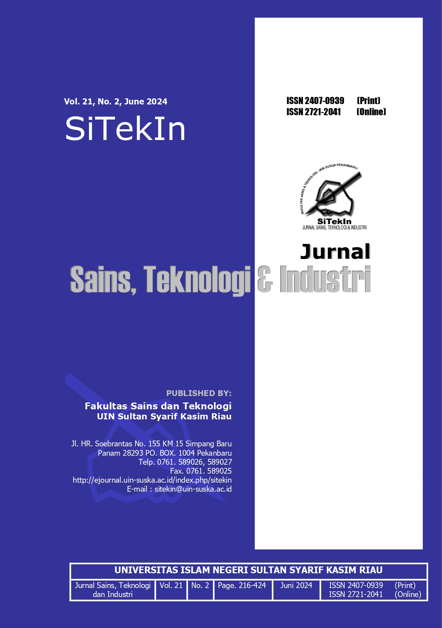Evaluation Of Irrigation Area Maintenance Budget Priority Determination Using The Analytical Hierarchy Process (AHP) Method
DOI:
https://doi.org/10.24014/sitekin.v21i2.26365Abstract
Determining the criteria for allocating maintenance funds is a problem in itself in maintaining irrigation areas apart from the problem of limited funds. Determining the allocation of funds based only on the level of damage without considering the characteristics of each irrigation area can lead to imbalances in the field. In the problem of determining priorities, decision makers are faced with several criteria in giving priority to maintenance budgets in irrigation areas, one of which is in Sragen Regency. One approach that is widely used to solve this problem is the Analytical Hierarchy Process (AHP). The AHP analysis model can solve problems that combine quantitative and qualitative data. The aim of this research is to determine which irrigation areas have the highest priority for maintenance based on the criteria of level of urgency, productivity, area size, cost. The questionnaire method is used to obtain primary data through questionnaire data collection and literature study to obtain secondary data. There are 5 irrigation areas that are the object of research, namely: 1. Kedung Duren Winong Irrigation Area, 2. Kedung Song Irrigation Area, 3. Garut Irrigation Area, 4. Karanganom Irrigation Area, 5. Buduran Irrigation Area. The result is that the order of criteria that have the priority (level) that most influences the budget allocation for maintenance of irrigation areas is Urgency Level 46.6%, Planting Productivity 24.4%, Area Area 14.5%, Cost 14.5% and obtained the priority percentage for budget allocation maintenance of irrigation areas, namely the Buduran Irrigation Area at 23.7%, the Kedung Duren Winong Irrigation Area at 21.7%, the Kedung Song Irrigation Area at 20.6%, the Garut Irrigation Area at 19.5%, the Karanganom Irrigation Area at 14.4%.
References
DPUPR Kab. Sragen. (2020). 2020 Performance Report for Irrigation Sector, DPUPERA Kab. Sragen. Sragen.
Sumaryanto, Siregar, M., & Hidayat, D. (2006). Evaluation of Irrigation Network Performance and Improvement Efforts. Center for Socioeconomic Analysis and Agricultural Policy, Department of Agriculture.
Edhisono, SH (2016, January 15). Optimizing Budgeting Distribution Model for Maintaining Irrigation Scheme. Retrieved September 12, 2021, from ejournal undip.ac.id/index.php/ijse: http://ejournal.undip. ac.id/index.php/semnastek.
Sumiyati, D. (2011). Application of Analytical Hierarchy Process (AHP) for Determining Subak Development Strategy. Agritech Journal, 31(2), 87–98.
Supriadi, A., Rustandi, A., Hastuti, D., Komarlina, L., & Ardiani, GT (2018). Analytical Hierarchy Process (AHP): Technique for Determining Competitive Strategy for Embroidery Crafts. Publisher Deepublish (CV Budi Utama Publishing Group).
Republic of Indonesia, Regulation of the Minister of Public Works and Public Housing of the Republic of Indonesia Number: 12/PRT/M/2015 dated 6 April 2015 concerning Exploitation and Maintenance of Irrigation Networks.
Widayanti, R. (2021). Analysis of Determining Irrigation Network Maintenance Priorities in Karanganyar Regency Using the AHP (Analytical Hierarchy Process) Method. Muhammadiyah University Surakarta Postgraduate School. Aldiansyah, M. (2022). Analysis of Impact of Traffic (Andalalin) Transmart Mall Area Jalan Tajur Bogor. ASTONJADRO: CEAESJ , Volume 11, pp. 263-274.
Amijaya, J., & Soimun, A. (2022). The Impact of the Construction of the Pertamina Refrigerated LPG Terminal on Traffic Performance on the Surrounding Road Network. Transportation Journal Vol. 22 No. 2 , 143-154.
Downloads
Published
Issue
Section
License
This work is licensed under a Creative Commons Attribution-ShareAlike 4.0 International License
Copyright Notice
An author who publishes in the SITEKIN Journal agrees to the following terms:
- Author retains the copyright and grants the journal the right of first publication of the work simultaneously licensed under the Creative Commons Attribution-ShareAlike 4.0 License that allows others to share the work with an acknowledgement of the work's authorship and initial publication in this journal
- Author is able to enter into separate, additional contractual arrangements for the non-exclusive distribution of the journal's published version of the work (e.g., post it to an institutional repository or publish it in a book) with the acknowledgement of its initial publication in this journal.
- Author is permitted and encouraged to post his/her work online (e.g., in institutional repositories or on their website) prior to and during the submission process, as it can lead to productive exchanges, as well as earlier and greater citation of the published work (See The Effect of Open Access).
Read more about the Creative Commons Attribution-ShareAlike 4.0 Licence here: https://creativecommons.org/licenses/by-sa/4.0/.

